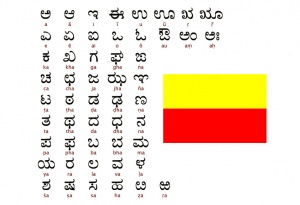Difference between revisions of "Language/Kannada/Pronunciation/Alphabet-and-Pronunciation"
Tag: Reverted |
Tag: Reverted |
||
| Line 1: | Line 1: | ||
[[File:Kannada-Alphabet.jpg|thumb]] | [[File:Kannada-Alphabet.jpg|thumb]] | ||
Kannada | Kannada, a Dravidian language, is predominantly spoken in Karnataka, a southwestern state of India. The Kannada alphabet (ಕನ್ನಡ ಲಿಪಿ) evolved from the Kadamba and Chalukya scripts, descendants of the Brahmi script, used between the 5th and 7th centuries AD. In the 19th century, under the influence of Christian missionary organizations, the Kannada and Telugu scripts were standardized. | ||
__TOC__ | |||
After completing this lesson, explore related topics: [[Language/Kannada/Grammar/Vowels|Vowels: Pronunciation and Writing]], [[Language/Kannada/Grammar/Conjuncts|Kannada Grammar Conjuncts]]. | |||
== Kannada Consonants == | |||
Kannada features a rich set of consonants, divided into structured and unstructured categories. | |||
{| class="wikitable" | {| class="wikitable" | ||
!'''Letter''' | !'''Letter''' | ||
| Line 115: | Line 116: | ||
|} | |} | ||
=== Kannada Structured Consonants === | |||
Structured consonants are grouped based on their articulation points. | |||
{| class="wikitable" | {| class="wikitable" | ||
! | ! | ||
!Voiceless | !Voiceless | ||
!Voiceless | !Voiceless Aspirate | ||
!Voiced | !Voiced | ||
!Voiced | !Voiced Aspirate | ||
!Nasal | !Nasal | ||
|- | |- | ||
!Velars | !Velars | ||
|ಕ (''ka'') | |ಕ (''ka'') | ||
| | |... | ||
!Labials | !Labials | ||
|ಪ (''pa'') | |ಪ (''pa'') | ||
| | |... | ||
|} | |} | ||
=== Kannada Unstructured | === Kannada Unstructured Consonants === | ||
Unstructured consonants don't fit into the above categories: | |||
* '''ಯ''' (ya) | * '''ಯ''' (ya) | ||
* | * ... | ||
* '''ೞ''' (ḻ; obsolete). | * '''ೞ''' (ḻ; obsolete). | ||
==Kannada Vowels== | |||
== Kannada Vowels == | |||
Kannada has 13 vowels, which are written with diacritics when following a consonant. | |||
{| class="wikitable" | {| class="wikitable" | ||
!'''Letter''' | !'''Letter''' | ||
| Line 189: | Line 155: | ||
|a | |a | ||
|[a] | |[a] | ||
| | |... | ||
|ಔ | |ಔ | ||
|ೌ | |ೌ | ||
| Line 250: | Line 161: | ||
|[oʷ] | |[oʷ] | ||
|} | |} | ||
== Practice and Application == | |||
Practice writing and pronouncing each consonant and vowel. Pay attention to structured consonants and vowel diacritics. | |||
== Further Learning == | |||
Continue your Kannada language journey with advanced topics such as sentence structure and verb conjugations. | |||
==Video: Pronunciation== | ==Video: Pronunciation== | ||
Revision as of 23:17, 14 November 2023
Kannada, a Dravidian language, is predominantly spoken in Karnataka, a southwestern state of India. The Kannada alphabet (ಕನ್ನಡ ಲಿಪಿ) evolved from the Kadamba and Chalukya scripts, descendants of the Brahmi script, used between the 5th and 7th centuries AD. In the 19th century, under the influence of Christian missionary organizations, the Kannada and Telugu scripts were standardized.
After completing this lesson, explore related topics: Vowels: Pronunciation and Writing, Kannada Grammar Conjuncts.
Kannada Consonants
Kannada features a rich set of consonants, divided into structured and unstructured categories.
| Letter | IPA |
|---|---|
| ಕ | [ka] |
| ಖ | [kʰa] |
| ಗ | [ɡa] |
| ಘ | [ɡʱa] |
| ಙ | [ŋa] |
| ಚ | [tʃa] |
| ಛ | [tʃʰa] |
| ಜ | [dʒa] |
| ಝ | [dʒʱa] |
| ಞ | [ɲa] |
| ಟ | [ʈa] |
| ಠ | [ʈʰa] |
| ಡ | [ɖa] |
| ಢ | [ɖʱa] |
| ಣ | [ɳa] |
| ತ | [t̪a] |
| ಥ | [t̪ʰa] |
| ದ | [d̪a] |
| ಧ | [d̪ʱa] |
| ನ | [n̪a] |
| ಪ | [pa] |
| ಫ | [pʰa] |
| ಬ | [ba] |
| ಭ | [bʱa] |
| ಮ | [ma] |
| ಯ | [ja] |
| ರ | [ra] |
| ಲ | [l̪a] |
| ವ | [ʋa] |
| ಶ | [ça] |
| ಷ | [ʂa] |
| ಸ | [sa] |
| ಹ | [ħa] |
| ಳ | [ɭa] |
Kannada Structured Consonants
Structured consonants are grouped based on their articulation points.
| Voiceless | Voiceless Aspirate | Voiced | Voiced Aspirate | Nasal | |
|---|---|---|---|---|---|
| Velars | ಕ (ka) | ... | Labials | ಪ (pa) | ... |
Kannada Unstructured Consonants
Unstructured consonants don't fit into the above categories:
- ಯ (ya)
- ...
- ೞ (ḻ; obsolete).
Kannada Vowels
Kannada has 13 vowels, which are written with diacritics when following a consonant.
| Letter | Diacritic | ISO | IPA | |||||
|---|---|---|---|---|---|---|---|---|
| ಅ | ◌ | a | [a] | ... | ಔ | ೌ | au | [oʷ] |
Practice and Application
Practice writing and pronouncing each consonant and vowel. Pay attention to structured consonants and vowel diacritics.
Further Learning
Continue your Kannada language journey with advanced topics such as sentence structure and verb conjugations.
Video: Pronunciation
Kannada Online Virtual Keyboard
